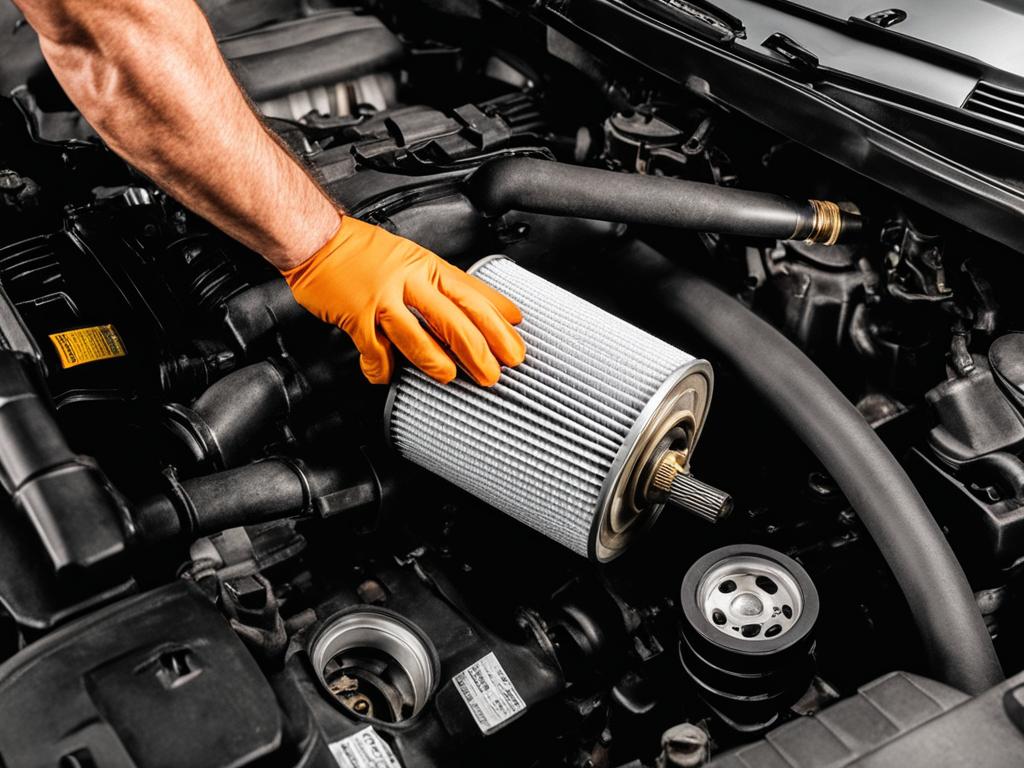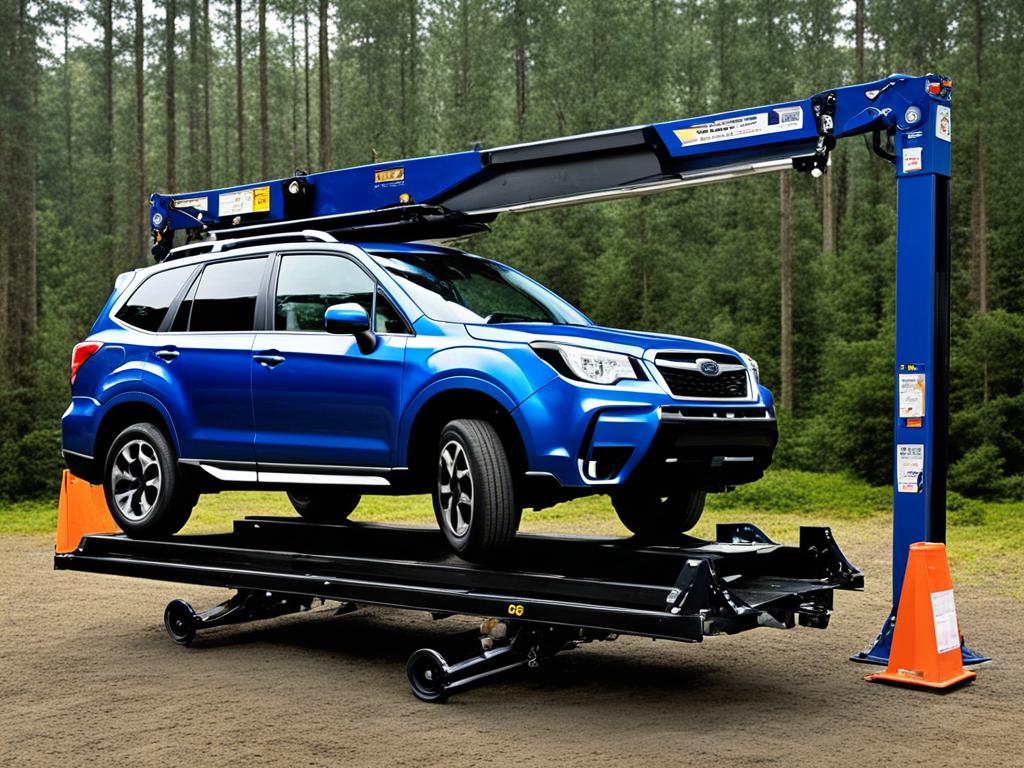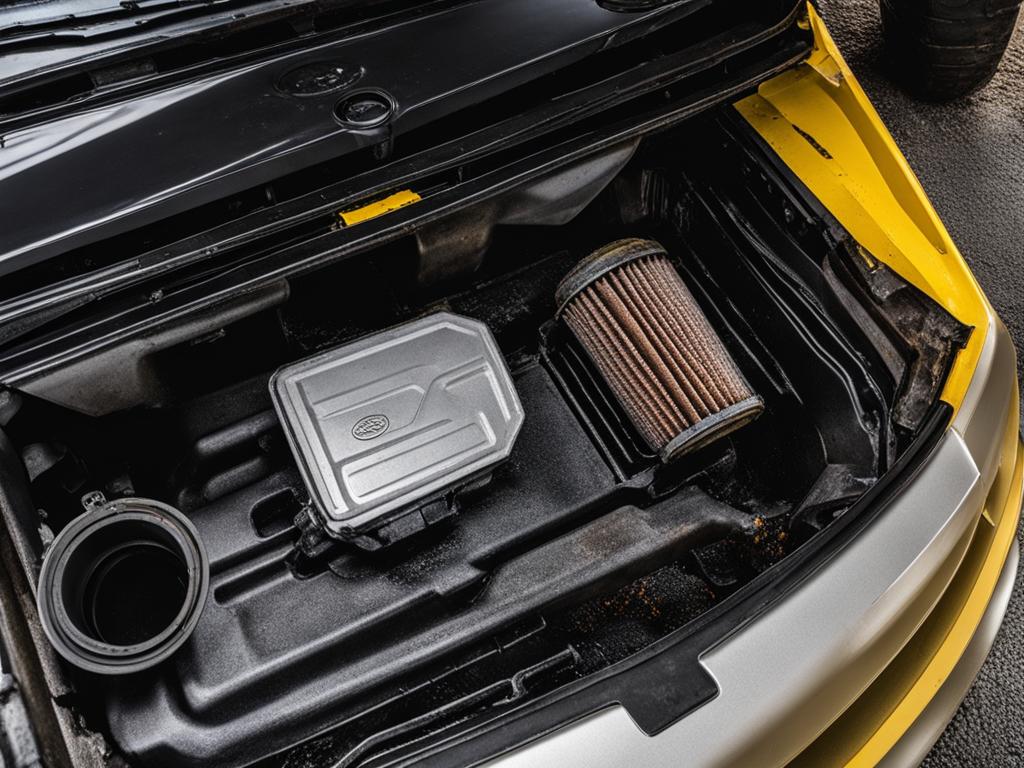Subaru Forester Oil Change Guide & Tips
Changing the oil in your Subaru Forester is an essential part of its regular maintenance. By following this comprehensive guide, you can ensure that your vehicle’s engine stays in optimal condition for years to come. We will cover the necessary tools and steps involved in performing an oil change, as well as provide tips for a successful DIY oil change.
Key Takeaways:
- Regular oil changes are crucial for maintaining the health and longevity of your Subaru Forester engine.
- Follow the specific oil change intervals recommended for your Subaru Forester model and year.
- Ensure you have the necessary tools and materials before starting the oil change process.
- Properly dispose of the old oil and filter to protect the environment.
- Consult your owner’s manual for detailed instructions and torque specifications.
Tools and Materials Needed for Subaru Forester Oil Change
To perform an oil change on your Subaru Forester, you will need the following tools and materials:
- Mechanic’s safety glasses
- WIX 57055 oil filter
- 65mm oil filter wrench
- 17mm 6pt socket
- 2″ to 4″ socket extension
- 4.5 quarts of 0-20W or 5-20W full synthetic motor oil (Valvoline Full Synthetic Advanced SAE 5W-20 is recommended)
These tools and materials will allow you to easily remove the old oil filter, drain the old oil, and replace it with fresh oil.
Performing an oil change is an important part of maintaining your Subaru Forester’s engine health. Using the right tools and materials ensures a smooth and efficient oil change process. The mechanic’s safety glasses protect your eyes from potential splashes or spills during the oil change.
The WIX 57055 oil filter is specifically designed for Subaru Forester models and provides optimal filtration to help keep your engine clean. The 65mm oil filter wrench helps you remove and install the oil filter with ease. The 17mm 6pt socket and 2″ to 4″ socket extension allow you to access and loosen the drain plug and perform other necessary tasks during the oil change.
Choosing the correct motor oil for your Subaru Forester is essential. The 0-20W or 5-20W full synthetic motor oil provides excellent lubrication and protection for your engine. Valvoline Full Synthetic Advanced SAE 5W-20 is a recommended choice due to its quality and compatibility with Subaru Forester engines.
By having these tools and materials ready, you can confidently perform an oil change on your Subaru Forester and ensure the longevity and optimal performance of your vehicle’s engine.
Preparing for the Oil Change
Before starting the oil change process for your Subaru Forester, it is crucial to ensure that you are adequately prepared. Following these steps will help you perform a successful oil change and maintain the optimal health of your vehicle’s engine.
Parking and Safety
First, park your Subaru Forester on a level surface and engage the parking brake. This will prevent any unintended movement during the oil change process. Additionally, make sure to wear appropriate safety gear, such as mechanic’s safety glasses, to protect your eyes from any potential hazards.
Allow Sufficient Cooling Time
Prior to beginning the oil change, allow the engine of your Subaru Forester to cool down for at least two hours. This ensures that the engine is not excessively hot, which could potentially cause burns or other safety concerns during the oil change process.
Determine the Oil Change Interval
Consult your owner’s manual to determine the appropriate oil change interval for your specific model and year of Subaru Forester. Different vehicles may have different recommended intervals, typically based on factors such as mileage or time. Following the manufacturer’s guidelines will help ensure that your engine receives the necessary maintenance it requires.

Summary:
Preparing your Subaru Forester for an oil change involves parking on a level surface, engaging the parking brake, allowing sufficient cooling time, and referencing the owner’s manual to determine the appropriate oil change interval. By following these steps, you can ensure a smooth and successful oil change process for your vehicle.
Accessing the Oil Filter and Drain Plug
To perform an oil change on your Subaru Forester, you will need to access the oil filter and drain plug. Here’s how:
- Raise the front body of your Subaru Forester: Use jacks and jackstands or place wood under the front wheels to elevate the car.
- Open the hood: Locate the oil filter and drain plug. The oil filter is positioned at the top of the engine, next to the oil filler cap. The drain plug is marked on the plastic splash guard underneath the car.
Consulting the Owner’s Manual and Forums
Before proceeding, consult your owner’s manual or Subaru Forester forums to ensure you have the correct torque specifications for the drain plug. Following these specifications is crucial for proper tightening and preventing leaks.
Image
Torque Specifications for the Drain Plug
Here are some examples of torque specifications for the drain plug on Subaru Forester models:
| Model Year | Torque Specification |
|---|---|
| 2014-2018 | 33 lb-ft (45 Nm) |
| 2019-2021 | 30 lb-ft (40 Nm) |
Note: Torque specifications may vary depending on the exact model year of your Subaru Forester. Always refer to your owner’s manual or consult Subaru Forester forums for the accurate torque specification for your specific vehicle.
Now that you know how to access the oil filter and drain plug, let’s move on to the next section: Removing and Replacing the Oil Filter.
Removing and Replacing the Oil Filter
When performing an oil change on your Subaru Forester, removing and replacing the oil filter is a crucial step to ensure the engine’s optimal performance. Follow these steps to complete this task successfully.

Clean the Filter Attachment and Mating Surface
Before removing the old oil filter, it’s essential to clean the “cup” of the filter attachment and the mating surface where the new oil filter will be placed. Use a clean cloth or towel to wipe away any debris or dirt.
Prepare the New Oil Filter
Prior to installing the new oil filter, add fresh engine oil to the filter and apply a light coating of oil to the filter gasket. This step ensures proper lubrication and a secure seal.
Install the New Oil Filter
Hand-tighten the new oil filter onto the filter attachment, ensuring it is snug but not overly tightened. Use an oil filter wrench to rotate the filter an additional 3/4 turn to secure it firmly in place.
Choose the Correct Oil Filter
It’s crucial to select the appropriate oil filter for your Subaru Forester model and year. Refer to the owner’s manual or consult a certified Subaru dealer to determine the correct oil filter type for your vehicle. Using the wrong oil filter can lead to inefficient filtration and potential engine damage.
Cost of the Oil Filter
The cost of an oil filter for a Subaru Forester can vary depending on several factors, including the brand, model, and where it is purchased. On average, the cost ranges from $10 to $20.
With the old oil filter effectively removed and the new oil filter securely in place, you can proceed to the next step of the oil change process. This ensures that your Subaru Forester’s engine receives proper lubrication and filtration, promoting its longevity and performance.
Draining the Old Oil
To complete the oil change procedure on your Subaru Forester, it is essential to drain the old oil from the engine. Follow these steps to drain the old oil and prepare your vehicle for fresh oil.
- Slide underneath the car and locate the oil drain plug on the plastic splash guard. The oil drain plug is a crucial component in the oil change process, and finding its location is essential for a successful oil change.
- Use a 17mm 6pt socket with a 2″ extension to unscrew the drain plug. This combination of tools will allow you to easily remove the plug and facilitate the oil draining process.
- Place an oil pan underneath the drain plug to collect the old oil as it drains from the engine. Ensuring that the oil pan is positioned correctly will prevent any spills and help maintain a clean working area.
- Allow the old oil to drain for approximately 5-15 minutes, ensuring that all of the remaining oil has been completely drained from the engine.
- Clean both the washer and drain plug thoroughly once the old oil has finished draining. Removing any debris or residue will help maintain the integrity of your vehicle’s oil system.
- Reinstall the clean washer and drain plug using the appropriate torque specifications. This step ensures a secure fit and prevents any potential leaks during subsequent oil changes.
By following these steps, you can effectively drain the old oil from your Subaru Forester’s engine and prepare for the next stage of the oil change process.
Expert Tip:
Always consult your owner’s manual or Subaru Forester forums to confirm the correct torque specifications for the drain plug. Following the manufacturer’s recommendations will help maintain the longevity and performance of your vehicle.
| Tools and Materials Needed |
|---|
| 17mm 6pt socket with a 2″ extension |
| Oil pan |
Adding Fresh Oil
After draining the old oil, it’s essential to add fresh oil to your Subaru Forester’s engine to ensure optimal performance and prolong its lifespan. When selecting the engine oil type, it’s important to consider the specific requirements of your vehicle, which may vary depending on the model and year. To find the recommended engine oil type for your Subaru Forester, refer to your owner’s manual or visit the manufacturer’s website.
Once you have identified the appropriate oil type, it’s crucial to add the right amount of oil to your engine. Consult your owner’s manual to determine the exact engine oil capacity for your Subaru Forester. Adding the correct amount of oil is necessary for proper lubrication and functioning of the engine.
After adding the oil, it’s recommended to run the engine for a short period to ensure the fresh oil is circulated throughout the system, providing effective lubrication to all necessary components.

Adding fresh oil to your Subaru Forester is a critical step in maintaining the health and performance of your vehicle’s engine. By using the recommended engine oil type and following the proper oil capacity, you can ensure that your Subaru Forester operates smoothly and efficiently.
Checking for Leaks and Proper Level
After completing the oil change, it is important to check for any potential leaks and ensure that the engine oil level is at the appropriate level. By performing these checks, you can ensure that your Subaru Forester is operating efficiently and avoid any potential issues.
“Regularly checking for leaks and maintaining the proper oil level is crucial for the optimal performance of your Subaru Forester.”
First, start the engine and let it run for 15-30 seconds. This allows the newly changed oil to circulate throughout the engine and ensures proper lubrication.
Next, shut off the engine and inspect the oil filter and the underside of the engine for any signs of leaks. Look for any oil drips or stains that may indicate a leak. If you notice any leaks, it is important to address them promptly to prevent any potential damage to the engine.
After checking for leaks, wait for 5 minutes to allow the oil to settle back into the oil pan. Once the waiting period is over, check the engine oil level using the dipstick. The dipstick is typically located near the engine oil filler cap and has markings indicating the appropriate oil level.
Insert the dipstick into the oil dipstick tube, fully seat it, and then remove it again. Wipe the dipstick clean with a cloth or paper towel, and then reinsert it into the tube. Pull it out once more and observe the oil level on the dipstick.
The oil level should be between the two dots on the dipstick, indicating that it is within the proper range. If the oil level is below the lower dot, you will need to add more oil to bring it to the recommended level.
Note: It is important to use the appropriate type and viscosity of oil recommended for your Subaru Forester, as specified in your owner’s manual.
If you need to add more oil, do so slowly and in small increments to avoid overfilling. After each addition, recheck the oil level using the dipstick until it reaches the recommended range.
Once you have confirmed that there are no leaks and the oil level is within the proper range, you can be confident that your Subaru Forester is ready to hit the road once again.

Lowering the Vehicle and Final Checks
Once you have confirmed the proper oil level and checked for leaks, it is time to lower the front body of your Subaru Forester and perform final checks. Follow these steps to complete the oil change process:
- Step 1: Remove the jacks or wood supporting the vehicle
- Step 2: Take a final look around the engine bay to ensure all tools and equipment have been removed
- Step 3: Close the hood securely
- Step 4: Disengage the parking brake
By carefully lowering the vehicle and conducting final checks, you can ensure the safety and readiness of your Subaru Forester before hitting the road.
Remember: Always prioritize safety and double-check that all components are functioning properly. Following these steps will help prevent any potential accidents or damage to your vehicle.

| Common Final Checks |
|---|
| Inspect for any loose parts or hoses in the engine bay |
| Ensure all fluids are topped up to their appropriate levels |
| Check that all lights (headlights, taillights, brake lights, etc.) are working |
| Test the brakes to make sure they are responsive |
| Verify that the steering wheel is aligned and not pulling to one side |
Disposing of Old Oil and Filter
Properly disposing of the old oil and filter is essential to protect the environment and ensure responsible waste management. Follow these steps to dispose of your Subaru Forester’s old oil and filter:
1. Collect the Old Oil
Pour the old oil into a clean container, such as an empty milk jug or an oil disposal container. Make sure to avoid spillage and contamination during the transfer. Use a funnel if necessary to prevent any oil from splashing or dripping.
2. Find a Local Waste Disposal Facility
Take the container with the old oil to a local waste disposal facility that accepts used motor oil. These facilities specialize in recycling used oil and have the necessary equipment to handle it safely. Check your local directory or online resources to find the nearest facility.
3. Dispose of the Old Filter
Place the old oil filter in a designated oil filter disposal bag. These bags are specifically designed to contain used filters and prevent oil leakage. Check with your local waste management authority or recycling center for information on proper disposal methods for oil filters in your area.
4. Follow Local Regulations
Ensure that you dispose of the old oil and filter in accordance with local regulations. Different municipalities may have specific guidelines for handling and recycling used oil and filters. Adhering to these regulations helps protect the environment and prevent any potential harm.

Remember, it’s important not to throw away the old oil or filter with regular household waste as this could lead to pollution and harm the ecosystem. By properly disposing of your Subaru Forester’s old oil and filter, you contribute to environmental preservation and sustainable waste management.
Conclusion
Performing regular oil changes on your Subaru Forester is crucial for maintaining the health and longevity of your engine. By following the steps outlined in this guide and using the recommended tools and materials, you can confidently complete an oil change at home. Remember to consult your owner’s manual for specific information related to your vehicle, such as oil change intervals and torque specifications.
With proper maintenance, your Subaru Forester will continue to run smoothly for many miles to come. Taking care of your engine by changing the oil regularly helps to remove contaminants and prevent engine damage. It also ensures that your engine is properly lubricated, reducing friction and extending its lifespan.
By performing oil changes at home, you can save time and money while still providing your Subaru Forester with the care it needs. Just make sure to follow all safety precautions and dispose of the old oil and filter responsibly. With regular oil changes and proper maintenance, you can enjoy the reliable performance of your Subaru Forester for years to come.
FAQ
What tools and materials do I need for a Subaru Forester oil change?
To perform an oil change on your Subaru Forester, you will need mechanic’s safety glasses, a WIX 57055 oil filter, a 65mm oil filter wrench, a 17mm 6pt socket, a 2″ to 4″ socket extension, and 4.5 quarts of 0-20W or 5-20W full synthetic motor oil. It is recommended to use Valvoline Full Synthetic Advanced SAE 5W-20. Make sure to choose the appropriate oil filter for your vehicle model and year.
How do I prepare my Subaru Forester for an oil change?
Before starting the oil change process, park your car on a level surface, set the parking brake, and allow the engine to cool down for at least two hours. Consult your owner’s manual to determine the correct oil change interval for your specific model and year.
How do I access the oil filter and drain plug on my Subaru Forester?
To access the oil filter and drain plug, raise the front body of your Subaru Forester using jacks and jackstands or by placing wood under the front wheels. Open the hood to locate the oil filter and drain plug. The oil filter is located at the top of the engine, next to the oil filler cap. The drain plug is marked on the plastic splash guard underneath the car. Consult your owner’s manual or Subaru Forester forums for the specific torque specifications for the drain plug.
How do I remove and replace the oil filter on my Subaru Forester?
To remove the old oil filter, clean the “cup” of the filter attachment and the mating surface that the new oil filter will contact. Add new engine oil to the new filter and apply a light coating of oil to the filter gasket. Install the new filter by hand-tightening it and then using an oil filter wrench to rotate it 3/4 turn more. Make sure to use the appropriate oil filter for your Subaru Forester model and year.
How do I drain the old oil from my Subaru Forester?
To drain the old oil, slide underneath the car and locate the oil drain plug on the plastic splash guard. Use a 17mm 6pt socket with a 2″ extension to unscrew the drain plug. Place an oil pan under the plug to collect the old oil as it drains. Once the old oil has drained for 5-15 minutes, clean the washer and drain plug, and then reinstall them using the appropriate torque specifications.
How do I add fresh oil to my Subaru Forester?
After draining the old oil, remove the oil pan and add fresh oil to the engine. The recommended engine oil type and capacity for Subaru Foresters vary depending on the model and year. Consult your owner’s manual or the manufacturer’s website for the correct oil type and capacity for your specific vehicle. It is crucial to add the appropriate amount of oil as specified in your owner’s manual. Run the engine for a short period after adding oil to ensure proper circulation.
How do I check for leaks and ensure the proper oil level in my Subaru Forester?
After completing the oil change, start the engine and let it run for 15-30 seconds. Shut off the engine and inspect the oil filter and the underside of the engine for any signs of leaks. Wait for 5 minutes and then check the engine oil level using the dipstick. The oil level should be between the two dots on the dipstick, indicating a proper oil level. If necessary, add more oil to bring the level within the recommended range.
How do I lower my Subaru Forester and perform final checks after an oil change?
Once you have confirmed the proper oil level and checked for leaks, lower the front body of your Subaru Forester by removing the jacks or the wood supporting it. Take a final look around the engine bay to ensure all tools and equipment have been removed. Close the hood securely and make sure the parking brake is disengaged before driving the vehicle.
How do I dispose of the old oil and oil filter?
Properly dispose of the old oil by pouring it into a clean container, such as an empty milk jug, and taking it to a local waste disposal facility for recycling. Put the old filter in a designated oil filter disposal bag and dispose of it according to your local regulations. Do not throw away the old oil or filter with regular household waste.




